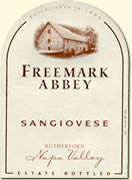 |
|
Wine Details
Price:
$28.00 per bottle
Description:
Lovely youthful purple color with good intensity. Aromas of cherries and raspberry jam are accented by a touch of oak. There’s lively acid with fruity flavors of cranberries and cherries, plus some depth from both cocoa and toast flavors. Moderate dusty tannins show some aging potential.
Percentage of each grape variety used: 75% Sangiovese, 13% Petite Sirah, 8% Cabernet Sauvignon 3% Merlot, 1% Zinfandel.
|
|
|